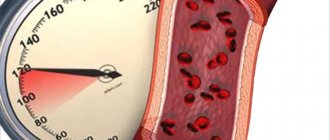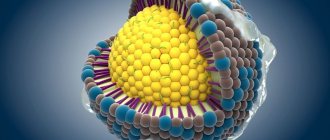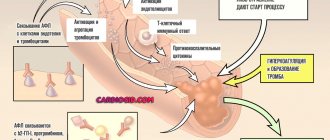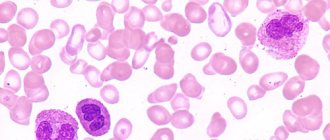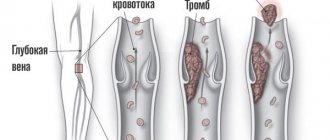Acid-base balance is one of the important indicators of health. As a rule, during the process of life, many different acids are formed in the body, which are quickly excreted through the lungs or with urine, then. If the balance is disturbed, acidosis may occur - a condition in which acids accumulate (accumulate) in the tissues and destroy them. Often this pathology appears due to a lack of minerals in adults and children. The disease is characterized by a shift in the acid-base balance towards a decrease in pH and an increase in the acidity of its environment.
Causes
Acidosis is not a disease, but only a condition of the body caused by an imbalance in the acid-base balance, which occurred as a result of insufficient excretion and oxidation of organic acids. As a rule, these products are eliminated quickly during normal functioning of the body. Only in some diseases and conditions do they come out slowly. The most common causes of acidosis are:
- respiratory failure due to pneumonia (pneumonia), emphysema (pathological expansion of the air spaces of the distal bronchioles) of the lungs, hypoventilation (rare shallow breathing);
- malignant neoplasms;
- fasting, diet;
- alcohol abuse;
- hypoglycemia (low blood glucose levels);
- renal failure;
- smoking;
- loss of appetite, poisoning, other disorders of the gastrointestinal tract (gastrointestinal tract);
- pregnancy;
- dehydration of the body;
- poisoning with harmful substances;
- oxygen starvation (with myocardial infarction, heart failure, anemia, shock);
- loss of bicarbonate (acid salts of carbonic acid) by the kidneys;
- use of drugs (calcium chloride, salicylates and others);
- conditions of the body that provoke metabolic disorders (circulatory failure, diabetes mellitus, febrile conditions).
Causes
The presence of a large accumulation of acidic products during acidosis can be caused by various reasons.
Factors influencing the development of acidosis can be both external and internal. External causes of acidosis include inhalation of air or vapors with a high carbon dioxide content.
Internal causes include functional disorders of body systems that affect metabolic processes and the removal of organic acid products.
The causes of the development of acidosis can be certain processes in the body: diabetes mellitus, circulatory disorders, tumor processes, pregnancy, hypoglycemia, hypoxic conditions of various origins, disorders of the kidneys, intoxication, fasting, side effects of medications, etc. In some cases, obvious reasons, leading to acidosis are not determined.
Regardless of the cause that caused it, acidosis negatively affects the entire body of the patient. The worst prognosis for severe acidosis is shock or death.
The consequences of acidosis can be dehydration, blood thickening, thrombosis, unstable blood pressure, myocardial, liver, spleen, etc., functional disorders in the blood circulation of the brain and metabolic processes in it, i.e. the state of acidosis entails disruption of the activity of all vital organs.
Kinds
According to its origin, acidosis is divided into: non-respiratory (this condition is caused by an excess of non-volatile acids), respiratory (gas acidosis) develops due to inhalation of air with a high concentration of CO2 (carbon dioxide) and mixed (caused by various types of acidosis) . The non-respiratory (non-gas) type also has its own classification:
- Exogenous. A state of increasing acid concentration, which is caused by the intake of a huge number of substances into the body that are converted into acids during metabolism.
- Excretory. It develops when the function of removing non-volatile acids from the body is impaired. Often occurs in renal failure.
- Acute metabolic acidosis. The most complex type of pathology, which is characterized by the accumulation of endogenous acids in the body as a result of their insufficient binding or destruction. Divided into:
- lactic acidosis develops due to an excess of lactic acid in the body;
- hyperchloremic, in which the acid balance is disturbed due to the high chlorine content in the blood plasma;
- diabetic, appears as a complication of diabetes mellitus and indicates the presence of ketonemia (high levels of acetone bodies in the blood) and hyperglycemia (increased amount of glucose in the blood serum).
The pH value also affects the acid-base balance, therefore, if, at a norm of 7.25 - 7.44, the pH level in the body reaches low (less than 7.24) or high (more than 7.45) values, protein denaturation occurs (i.e. e. loss of their natural properties), decreased enzyme function and cell destruction - this condition can lead to the death of the body. Acidosis according to pH level is classified as:
- Compensated acidosis. A shift in blood pH occurs towards the lower limit of the physiological norm - up to 7.35. There are often no symptoms.
- Subcompensated. Shift to the “acidic” side – pH 7.35-7.29. Possible arrhythmia, shortness of breath, vomiting, diarrhea
- Decompensated acidosis. A decrease in blood pH level less than 7.29. In this condition, disorders of the digestive system, heart, and brain are clearly expressed.
Article on the topic: Screening during pregnancy - timing, indications, methods and purposes of research
Metabolic acidosis - what is it?
Pathological oxidation of the blood, known as metabolic acidosis - what is it in adults? Against the background of poor removal of organic acids from the body or their poor-quality oxidation, this disease develops. Acidic foods accumulate in tissues. Depending on the provocateurs of the phenomenon and the degree of severity, several types of violations are distinguished (according to hydrogen indicators):
- compensated (pH = 7.35);
- subcompensated (indicator varies from 7.25 to 7.34);
- decompensated (pH = 7.25 and below).
Metabolic acidosis (of any type) cannot develop on its own and is always a consequence of some disease. According to another classification, there are three types of pathology:
- Ketoacidosis
– diabetic and non-diabetic. Formed against the background of diabetes mellitus or other underlying causes. - Hyperchloremic origin
- a consequence of insufficient sodium bicarbonate or loss of sodium bicarbonate (for example, as a result of diarrhea). - Lactic acidosis
, which is a large accumulation of lactic acid.
Compensated metabolic acidosis
Metabolic acidosis is a compensated pathology. It is characterized by a change in the absolute amounts of the components of the carbonate buffer. Physiological compensation mechanisms do not allow the pH to move beyond the physiological norm. There is an increase in breathing, pressure and heartbeat at a pH of 7.35 (virtually unchanged). The ratio of carbonic acid and sodium salt of this acid remains within the normal range, it is 20:1.
Decompensated metabolic acidosis
Uncompensated acidosis has other indicators. The absolute amount of sodium bicarbonate and carbonic acid and their ratio change. The compensation effect is insufficient, the concentration of hydrogen ions increases, and this leads to a decrease in blood pH, acidosis becomes decompensated. The functioning of the gastrointestinal tract, central nervous and cardiovascular systems, and so on is disrupted.
Symptoms
Manifestations of imbalance in the human body are difficult to distinguish from the symptoms of other diseases. As a rule, with a mild form of acidosis, a person cannot even suspect a shift in the acid-base balance. Therefore, only an experienced specialist can make an accurate diagnosis. Although there are general signs of acidosis in humans:
- short-term vomiting, nausea;
- loss of consciousness;
- general malaise;
- dizziness;
- cardiac arrhythmia (impaired rhythm and heart rate);
- dyspnea;
- increased blood pressure (blood pressure);
- drowsiness;
- increasing stupor
- increased heart rate;
- lethargy;
- confusion;
- state of shock;
- hyperpnea (increased frequency and depth of breathing).
In children
As a rule, acidosis in children occurs when there is a large combustion of fats as a result of the lack of carbohydrates. This often happens when a child has diabetes or poor diet. Other causes of acid-base imbalance in children are diarrhea, kidney failure, poor intestinal absorption, and Addison's disease. The main symptoms of acidosis in a child are:
- loss of appetite;
- lethargy;
- depressed state of the central nervous system (CNS);
- rapid breathing;
- stupor;
- disturbance of peripheral microcirculation (pallor, marbling of the skin);
- stomach problems;
- diarrhea, vomiting, leading to dehydration;
- Diabetics have a characteristic rotten odor from the mouth;
- headache;
- heat.
Large toxic breath - the main sign of acidosis, as a rule, rarely occurs in newborns. Only when there is a metabolic type of acid-base imbalance, the breathing of babies becomes irregular and incorrect. With respiratory distress syndrome (respiratory failure), accompanied by a mixed severe type of acidosis, the child’s breathing becomes paradoxical - pendulum-like air movements appear from the lung on the healthy side to the opposite side and back.
Symptoms of acidosis
Symptoms of acidosis are difficult to differentiate from signs of various diseases, and in mild forms they are not at all associated with a violation of acid-base balance.
Symptoms of mild acidosis may include:
- Short-term nausea and vomiting;
- General malaise;
- Fatigue;
More severe conditions of acidosis may be accompanied by:
- Cardiac arrhythmia;
- Central nervous system disorders: lethargy, dizziness, confusion, drowsiness, loss of consciousness;
- Shortness of breath;
- Hyperpnea (increased depth of breathing and then its frequency);
- Increased heart rate;
- Signs of a decrease in the volume of extracellular fluid (ECF), especially with diabetic acidosis;
- Increased blood pressure;
- Increasing deafness.
Severe acidosis can lead to circular shock, which develops as a result of impaired myocardial contractility and the response of peripheral vessels to catecholamines.
Diagnostics
If any of the symptoms of acid-base imbalance occur, a person should definitely consult a doctor. Only a specialist can make an accurate diagnosis and prescribe effective treatment. To do this, the doctor may prescribe the following diagnostic methods:
- blood test for serum electrolytes (blood is taken from an artery);
- urine pH level analysis;
- blood gas analysis (arterial blood is taken from the radial artery at the wrist, but venous blood does not allow an accurate determination of the pH level).
As a rule, all blood tests (for the level of serum electrolytes and gas composition) show both the presence of the disorder itself in the body and its type (metabolic, respiratory and others). Often, to determine the factors causing acidosis, the doctor may prescribe additional diagnostic methods (urinalysis, ultrasound).
Correction of acidosis
Considering that acidosis is not an independent disease, but occurs as a consequence of other disorders, correction of acidosis is primarily aimed at treating the underlying disease or regulating dysfunctions in the body.
To correct acidosis of metabolic origin, intravenous fluid administration and treatment of the underlying pathology are prescribed.
Sodium bicarbonate in combination with glucose or sodium chloride is used in severe cases of acidosis.
Symptomatic treatment is used for minor acidosis. Dialysis is used in cases of acute poisoning of the body.
Treatment of acidosis
Due to the fact that the appearance of acidosis is caused by a disruption in the functioning of the body's systems, treatment of this condition is reduced to the treatment of the underlying disease or dysfunction that provoked a shift in the acid-base balance. Acidosis of any kind can lead to critical conditions of the body, so it is necessary to seek help from a specialist if symptoms appear. As a rule, correction of severe forms of pathology involves:
- strengthening the buffer hydrocarbonate system;
- improvement of pulmonary ventilation;
- elimination of hypoproteinemia (decrease in protein concentration in blood plasma);
- normalization of hemodynamics: elimination of hypovolemia (decreased blood volume), restoration of microcirculation;
- improvement of oxidative processes by introducing glucose, pyridoxine, ascorbic acid, Thiamine, Riboxin, Insulin;
- correction of electrolyte metabolism;
- elimination of the provoking factor;
- improvement of renal blood flow.
Article on the topic: Causes of kidney hydronephrosis - symptoms, diagnosis and treatment methods
Symptomatic treatment of the disease involves ingesting sodium bicarbonate (soda), drinking plenty of fluids, and eliminating associated symptoms (nausea, malaise, arrhythmias). In case of poisoning, drugs are prescribed that remove toxins from the body; in severe cases, dialysis (cleansing) is performed. With a moderate disorder, it is necessary to limit the consumption of protein foods. Drug treatment includes the use of calcium carbonate.
To treat metabolic disorders, nicotinic and glutamic acids and Cocarboxylase are prescribed. For acute forms of acidosis, rehydration salt is used. Dimephosphone is also often used to correct the pathological condition. In the treatment of lactic acidosis, the drug Dichloroacetate is used, which activates a complex of enzymes. In addition, the patient must maintain a proper and balanced diet and avoid coffee and alcohol.
Metabolic acidosis - causes
When metabolic acidosis is diagnosed, the pathogenesis is as follows: the concentration of bicarbonate in the blood plasma decreases, and the concentration of chlorine anions, on the contrary, increases. Potassium cations leave the cell and sodium and hydrogen cations enter in exchange. Excess potassium is excreted in the urine, but intracellular hypokalemia develops. Acidification of the body is provoked by various unfavorable factors. Metabolic acidosis develops for various reasons. Among them:
- unhealthy lifestyle, addiction to alcohol and smoking;
- prolonged fasting or, on the contrary, excess fat in food;
- renal dysfunction;
- liver diseases;
- insulin deficiency, diabetes;
- presence of heart and cancer diseases;
- drug overdose and other factors.
Nutrition
The best way to prevent acid-base imbalance is to eat healthy foods. One-sided nutrition is the main reason causing this pathological condition. This is, as a rule, the predominance of confectionery, bakery, and meat products in the diet. Although proper nutrition alone is not enough, doctors also advise including moderate physical activity. After all, sports activities significantly improve ventilation of the lungs, so a large amount of oxygen enters the body, which promotes the metabolism of acids.
To restore balance and get rid of acidosis, you should drink more fluids, non-carbonated mineral water and include the following foods in your diet:
- lean meat;
- buckwheat, oatmeal;
- herbal, green tea;
- fresh berries, fruits, vegetables;
- whole grains;
- rice water
When treating acidosis, you should forget about rich broths, sour borscht, marinades, and savory vegetable snacks. It is also necessary to limit the consumption of fast carbohydrates, because... During their digestion, a huge amount of acid is formed. Prohibited products:
- potato;
- baked goods, sweets;
- pasta;
- animal fats;
- carbonated drinks;
- canned food;
- sausage, frankfurters;
- alcohol;
- black tea, coffee;
- chips, crackers.
Therapy
Since acidosis occurs due to impaired functioning of the body's systems and organs, the course of treatment is based on the treatment of the disease or dysfunction that led to a shift in the acid-base balance. Any type of acidosis can significantly weaken the body, so at the first suspicion of this pathology, rush to visit a specialist. Typically, treatment of complex forms of acidosis includes the following items:
- improvement of pulmonary ventilation;
- decrease in the amount of protein in the blood plasma;
- strengthening the buffer hydrocarbonate system;
- restoration of blood microcirculation, reduction of its volume;
- normalization of oxidation processes by introducing glucose, ascorbic acid, Riboxin, Pyridoxine, Thiamine, Insulin;
- elimination of the cause of pathology;
- normalization of electrolyte metabolism;
- improving blood flow in the kidneys.
To eliminate symptoms, treatment of acidosis involves the following: ingesting a certain amount of soda (sodium bicarbonate); increased drinking; elimination of additional symptoms such as arrhythmia, nausea, lethargy. If poisoning is detected, medications are prescribed to remove toxic substances from the body; in especially severe situations, it is necessary to cleanse the body. If the acidosis has not become acute, it is worth reducing the consumption of protein foods. An excellent medication is calcium carbonate.
To get rid of metabolic acidosis, glutamic and nicotinic acids, as well as cocarboxylase, are prescribed. Acute forms of acidosis must be treated with rehydration salts. Even if the acid-base balance is disturbed, take Dichloroacetate, which activates enzymes. In addition to medications, the patient should eat a balanced diet and eliminate alcohol and coffee from the diet.
On a note! When treating symptoms of acidosis, the ratio of acids and alkalis must be monitored. For this purpose, an ionogram is constantly taken during therapy.
Prevention
Violations of the acid-base balance can be avoided if you watch your diet, walk more in the fresh air and give up bad habits (smoking, alcohol). In addition, to prevent acidosis, the following recommendations must be followed:
- promptly treat any metabolic disorders;
- raw plant foods should predominate in the diet;
- You must drink at least two liters of clean water;
- You should play sports to improve blood supply to all organs and normalize the functioning of the respiratory system;
- to quickly relieve symptoms of poisoning, you can drink a soda solution;
- It is necessary to control the quality of drinking water and monitor the level of its hardness (saturation with minerals).
Prevention of acidosis
To prevent acidosis, it is necessary to take a very careful approach to the issue of a balanced diet and timely treatment of existing diseases. White bread, eggs, cheeses, meat, animal fats, eaten without restrictions, do more harm than good. Therefore, to prevent acidosis, it is necessary to use these products in moderation. Do not abuse coffee and alcohol. It is advisable to consume as many vegetables and fruits raw as possible.
Prerequisites for preventing acidosis are preventive visits to the doctor and careful treatment of already acquired diseases.
Preventive actions
In order not to encounter the problem of disturbed acid-base balance, and therefore to avoid the consequences and symptoms of acidosis, you must adhere to a number of rules. First of all, it is recommended to eat a healthy and balanced diet, take care of the quality of the products consumed, spend more time in the fresh air, engage in active sports, and also give up bad habits, in particular, the abuse of alcoholic beverages and cigarettes. Also, to prevent acidosis, doctors give the following recommendations:
- pay attention to any metabolic disorders in a timely manner in order to take therapeutic measures to prevent further consequences;
- food should consist mainly of raw products of plant origin;
- play more sports, move actively, because this promotes improved blood supply to all organs and normalizes the functioning of the respiratory system;
- drink more liquid, but do not forget about clean water, its amount should be approximately 2 liters;
- to quickly relieve the unpleasant symptoms of poisoning, you can drink a soda solution;
- Monitor the quality of drinking water and the degree of its saturation with minerals and nutrients.
As it turned out, acidosis is not a serious disease or dangerous pathology, it is just a temporary condition of the body, so there is no need to panic. But the clinical picture of a disturbed acid-base balance can be extremely unpleasant, so if you experience discomfort, you should not leave things to chance. Do not self-medicate, consult a doctor immediately. Only a specialist can make the correct diagnosis, identify the type of acidosis and prescribe competent and effective treatment accordingly.
Complications and prognosis
Acidosis is a clear symptom that a metabolic disorder occurs in the human body. The main cause can be very serious diseases.
Therefore, if the main cause of acidosis is not eliminated, then there is a risk that the amount of acids of organic origin in the blood will constantly increase. This will lead to rapid depletion of compensatory mechanisms. In especially severe cases, this phenomenon can result in a prolonged coma for a person.
If you are faced with a problem such as acidosis, then do not panic. It is important to undergo a timely examination by specialists and establish the true cause of the development of such a condition in the body. After this, it will be possible to begin treatment. If you choose the right therapy, acidosis is eliminated quickly enough without any dangerous consequences for the human body.
Take care of your diet and lead a healthy and active lifestyle. In this case, the likelihood of encountering the problem of acidosis and disturbed acid-base balance is incredibly low. In addition, the metabolism will always be normal, which will have an extremely positive effect on a person’s condition and his health. Despite the fact that this is not a completely serious disorder in the body’s functioning, it should not be taken lightly. In some cases, the consequences of acidosis can be quite serious if this pathology develops along with other diseases. Avoid metabolic disorders, however, if this happens, you must seek help from a doctor as soon as possible to undergo a clinical examination in order to make an accurate and correct diagnosis.
